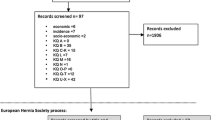Abstract
Objectives
To evaluate objective and subjective outcomes of patients undergoing laparoscopic repair of large hiatal hernia, either with or without resorbable mesh augmentation. The primary outcome of the study was anatomical recurrence rate as measured by endoscopy. Secondary outcomes were safety, efficacy, and long-term quality of life.
Methods
This was an observational cohort study. Patients who underwent laparoscopic repair of large (≥5 cm) type III hiatal hernia were included. Criteria of exclusion were previously failed hiatus hernia repair and emergency procedures. Patients were stratified into mesh group (mesh-augmented crura repair plus fundoplication) and non-mesh group (standard crura repair plus fundoplication). Preoperative and postoperative symptoms were assessed using the GERD-HRQL questionnaire. Upper gastrointestinal endoscopy was routinely performed between 6 and 12 months postoperatively and was repeated over the follow-up every 1–2 years or as needed. Anatomical hernia recurrence was defined as the maximum vertical length of stomach being at least 2 cm above the diaphragm.
Results
A total of 84 patients, 41 in the mesh group and 43 in the non-mesh group, operated between October 2009 and October 2014, were included in the study. All surgical procedures were completed laparoscopically. The median follow-up was 24 (IQR 29) months. There were 12 endoscopic recurrences, 4 in the mesh group and 8 in the non-mesh group. The five-year recurrence-free probability was similar in the two groups, but an earlier failure rate was noted in the non-mesh group at 12 months (p = 0.299). Three of the 12 patients with anatomical recurrence were symptomatic but did not require a reoperation. Univariate Cox proportional hazard analysis indicated that Toupet fundoplication may reduce the recurrence rate compared to Nissen fundoplication. No mesh-related complications occurred.
Conclusions
Laparoscopic repair of large hiatal hernia is effective and durable. Crura reinforcement with a resorbable synthetic mesh is safe and may protect from early anatomical recurrence.


Similar content being viewed by others
References
Kaplan JA, Schecter S, Lin MYC, Rogers S, Carter JT (2015) Morbidity and mortality associated with elective or emergency paraesophageal hernia repair. JAMA Surg 150(11):1094–1096
Hashemi M, Peters JH, DeMeester TR, Huprich JE, Quek M, Hagen JA et al (2000) Laparoscopic repair of large type III hiatal hernia: objective follow-up reveals high recurrence rate. J Am Coll Surg 190(5):553–560
Frantzides CT, Carlson MA, Loizides S et al (2010) Hiatal hernia repair with mesh: a survey of SAGES members. Surg Endosc 24:1017–1024
Furnée EJB, Smith CD, Hazebroek EJ (2015) The use of mesh in laparoscopic hiatal hernia repair: a survey of European surgeons. Surg Laparosc Endosc Percutaneous Tech 25:307–311
Asti E, Bonavina L, Lombardi M, Bandera F, Secchi F, Guazzi M (2015) Reversibility of cardiopulmonary impairment after laparoscopic repair of large hiatal hernia. Int J Surg Case Rep 14:33–35
Velanovich V (1998) Comparison of generic (SF-36) vs disease-specific quality of life (GERD-HRQL) scales for gastroesophageal reflux disease. J Gastrointest Surg 2(2):141–145
Vandenbroucke JP, von Elm E, Altman DG, Gotzsche PC, Mulrow CD, Pocock SJ, Poole C, Schlesselman JJ, Egger M, for the STROBE initiative (2007) Strengthening the reporting of observational studies in epidemiology (STROBE): explanation and elaboration. PLoS Med 4(10):1628–1654
Peeters E, van Barneveld KW, Schreinemacher MH et al (2013) One-year outcome of biological and synthetic bioabsorbable meshes for augmentation of large abdominal wall defects in a rabbit model. J Surg Res 180(2):274–283
Smithson M, Verkuilen J (2006) A better lemon squeezer? Maximum-likelihood regression with beta-distributed dependent variables. Psychol Methods 11(1):54–71
Hunger M, Baumert J, Holle RV (2011) Analysis of SF-6D index data: is beta regression appropriate? Value Health 14(5):759–767. doi:10.1016/j.jval.2010.12.009
Cribari-Neto F, Zeileis A (2010) Beta Regression in R. J Stat Softw 34(2):1–24
R Development Core Team (2015) A language and environment for statistical computing. R Foundation for Statistical Computing. Vienna, Austria. ISBN 3-900051-07-0
Oelschlager BK, Pellegrini CA, Hunter J, Soper N, Brunt M, Sheppard B et al (2006) Biologic prosthesis reduces recurrence after laparoscopic paraesophageal hernia repair: a multicenter, prospective, randomized trial. Ann Surg 244(4):481–490
Oelschlager BK, Pellegrini CA, Hunter JG, Brunt ML, Soper NJ, Sheppard BC et al (2011) Biologic prosthesis to prevent recurrence after laparoscopic paraesophageal hernia repair: long-term follow-up from a multicenter, prospective, randomized trial. J Am Coll Surg 213(4):461–468
Carlson MA, Condon RE, Ludwing KA, Schulte WJ (1998) Management of intrathoracic stomach with polypropylene mesh prosthesis reinforced transabdominal hiatus hernia repair. J Am Coll Surg 187:227–230
Granderath FA, Schweiger UM, Kamolz T, Asche KU, Pointner R (2005) Laparoscopic Nissen fundoplication with prosthetic hiatal closure reduces postoperative intrathoracic wrap herniation: preliminary results of a prospective randomized functional and clinical study. Arch Surg 140(1):40–48
Tam V, Winger DG, Nason KS (2015) A systematic review and meta-analysis of mesh versus suture cruroplasty in laparoscopic large hiatal hernia repair. Am J Surg. doi:10.1016/j.amsurg.2015.07.007
Watson DI, Thompson SK, Devitt PG et al (2015) Laparoscopic repair of very large hiatus hernia with sutures vs absorbable vs non-absorbable mesh- a randomized controlled trial. Ann Surg 261:282–289
Koetje JH, Irvine T, Thompson S, Devitt PG, Woods SD, Aly A et al (2015) Quality of life following repair of large hiatal hernias is improved but not influenced by use of mesh: results from a randomized controlled trial. World J Surg. doi:10.1007/s00268-015-2970-3
Stadlhuber RJ, Sherif AE, Mittal SK, Fitzgibbons RJ Jr, Brunt ML, Hunter JG et al (2009) Mesh complications after prosthetic reinforcement of hiatal closure: a 28-case series. Surg Endosc 23(6):1219–1226
Author information
Authors and Affiliations
Corresponding author
Ethics declarations
Disclosures
Dr. Asti, Lovece, Milito, Sironi, Bonitta, and Siboni have no conflicts of interest or financial ties to disclose. Dr. Bonavina has been consultant for Torax Medical.
Rights and permissions
About this article
Cite this article
Asti, E., Lovece, A., Bonavina, L. et al. Laparoscopic management of large hiatus hernia: five-year cohort study and comparison of mesh-augmented versus standard crura repair. Surg Endosc 30, 5404–5409 (2016). https://doi.org/10.1007/s00464-016-4897-7
Received:
Accepted:
Published:
Issue Date:
DOI: https://doi.org/10.1007/s00464-016-4897-7




